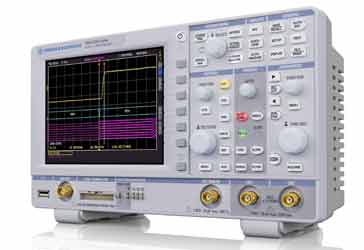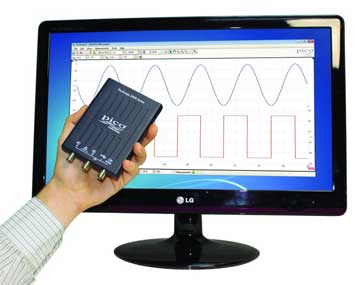USB vs Bench Top Oscilloscopes
There are some compelling arguments for using both USB oscilloscopes and bench top or standalone scopes: find out which is actually the best for your situation.
Oscilloscope Tutorial Includes:
Oscilloscope basics
Oscilloscope types
Specifications
USB vs bench-top scope
How to use an oscilloscope
Scope triggering
Oscilloscope probes
Oscilloscope probe specifications
Scope types includes:
Analogue scope
Analogue storage scope
Digital phosphor scope
Digital scope
USB / PC scope
Mixed Signal Oscilloscope MSO
Ever since the first USB oscilloscopes have appeared on the market, there have been many discussions about which is best: a bench top or standalone oscilloscope or a USB oscilloscope.
Many people argue strongly in favour of the bench top, whereas others love the USB scopes.

For many people, a bench top scope may be the best, whereas for others a USB one is better. In reality, both types can perform very well provided that a scope with a good pedigree is bought.
To understand the which might be better, I'll take a look at the pros and cons or both types. In this way it will be possible to understand what might be best for any given situation.
First it is worth taking a quick look at both types of scope along with their advantages and disadvantages.
Bench top scope
The bench top scope has been the mainstay of the oscilloscope test and measurement industry for many years. Dating back to the early days of electronics when people wanted to see waveforms on a screen.
Many of the early scopes were placed on trolleys so they could be moved from one bench to another as they were needed - they were too heavy to be man-handled easily.

Nowadays bench top scopes are just that and they are very compact, packing in a huge amount of functionality into a very small footprint. Even the depth of the scopes these days is quite small, enabling them to be placed very easily on any bench.
These bench-top scopes have the screen and all the controls on the front panel, and there are normally also interfaces to enable them to be connected to computers should this be required. Ethernet and USB are two common interfaces.
Bench-top scope advantages
Screen & controls on instrument: One of the big advantages for many people is that the controls and screen are on the instrument. This means that the instrument is more self contained, and often easier to use.
Controls are direct and not via menu: The important controls are available directly using switched and rotary controls, rater then being accessed via a computer screen and mouse. Some controls may be accessed via a menu, but thee are normally special functions etc.
Fits what many people are familiar with: Although USB scopes have been around for many years, a lot of people are more familiar with the bench top format for a scope and want to continue using a scope with this layout. With familiarity comes better use of a test instrument, so even though it is a personal preference rather than a technical reason, it still has merit.
Perception of better quality: With a bench top scope, there is a perception of better quality. However with USB scopes, there are good and bad. It pays to investigate which is actually best in reality as there are some very good USB scopes around, as well as bench top scopes.
Bench-top scope disadvantages
Takes up bench space: One of the disadvantages of bench top scope is that it can take up more space n the bench. This can be an issue where work-space is limited, so it is worth considering how much of an issue this might be.
Higher cost: The cost of a bench top scope has to be higher than an equivalent USB scope. The display and many of the functions are part of the scope and these are external to a USB scope, so it stands to reason that a bench top scope will be more expensive for equivalent functionality.
USB scope
In recent years, there has been a growing number of USB copes available on the market. These offer excellent value, but as with any test instrument, it pays to make sure that a good quality one is obtained as the low end of the market has a number of low performance models.

USB scope advantages
Lower cost for given performance: One of the big advantages of the USB scope is its cost advantage. As the scope uses a computer to provide elements such as the display, controls and the general MMI, it does not have to provide these as part of the instrument.
Less bench space: The space occupied by the USB oscilloscope itself will be relatively small compared to that of a full oscilloscope. This can be a great benefit when a scope is needed but space is short.
Ease of exporting data: As the data from the oscilloscope is already on a computer, it can often be easier to export the data in a variety of formats. Although many bench-top scopes have this facility, it does mean connecting to a computer, whereas for the USB scope, it is already in the computer.
USB scope disadvantages
Controls accessed via computer interface: As would be expected, all the controls for the USB scope need to be accessed via a computer interface. Many people are not that keen on virtual controls because they require a little more manipulating compared to a knob or switch on a front panel.
A computer needs to be factored in: The cost and space occupied by the computer need to be factored into use of the USB scope. If a computer is already going to be used, then this is fine, otherwise it needs to be a consideration.
May not be available for all computer operating systems: Although USB scopes generally work within a Windows environment, other operating systems are not always accommodated. Linux and iOS may not be supported. Many other better USB scopes will support the additional operating systems, but lower end ones are more likely to be Windows only.
Summarising the advantages & disadvantages
There are many points to consider when selecting a scope and making the choice between bench top and a USB scope.
| Comparison of Bench Top and USB Oscilloscopes |
||
|---|---|---|
| Attribute | Bench top | USB |
| Controls | Real | Virtual |
| Display | On scope | On computer |
| Display size | Limited by test instrument size | Limited by computer display size |
| Computer | If needed | Essential |
| Cost | Higher | Lower ** |
| Performance | Not affected by format | Not affected by format |
| Size | Larger | Smaller ** |
** this does not include the computer which is required for its operation.
At the end of the day, the decision about whether to opt for a bench top scope or a USB scope will be down to many different considerations. It should not be forgotten that the high end USB scopes compete well in terms of performance with the high end bench top scopes. But after deciding on the specification required, many of the considerations will be down to aspects including whether a computer is already there, as well as cost considerations. And of course personal preference as this has a major impact on the enjoyment of using a scope.
 Written by Ian Poole .
Written by Ian Poole .
Experienced electronics engineer and author.
More Test Topics:
Data network analyzer
Digital Multimeter
Frequency counter
Oscilloscope
Signal generators
Spectrum analyzer
LCR meter
Dip meter, GDO
Logic analyzer
RF power meter
RF signal generator
Logic probe
PAT testing & testers
Time domain reflectometer
Vector network analyzer
PXI
GPIB
Boundary scan / JTAG
Data acquisition
Return to Test menu . . .




